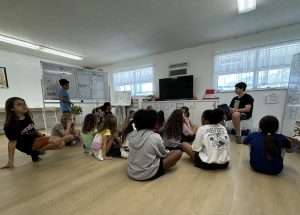Many are apprehensive about incorporating AI into education. But that shouldn’t stop us from exploring this new world of possibilities.
“What are you wildly excited about learning?”
This question, scrawled on our classroom whiteboard at Acton Academy Fort Lauderdale, set the stage for an unconventional day. Amaan Ahmad and Sidharth Jain, recent university graduates from Imperial College London and co-founders of Pathfinder AI, were visiting our school. These education entrepreneurs are focused on enabling AI to support young learners with their educational journeys.
As our elementary-aged learners explored the Pathfinder interface, their eyes lit up with all the options to explore. For me, it wasn’t just the technology that I was excited about. It was watching soft skills bloom in real time: critical thinking as they formulated queries, creativity as they explored new ideas, and collaboration as they shared discoveries.
Amaan and Sid recounted their visit:
Visiting Acton Academy confirmed our thesis: learner-centric environments are the future of education, and AI makes this scalable. We saw young learners naturally embrace AI as a collaborative partner, using it to transform wild ideas into tangible projects. It’s not just about delivering information; it’s about fostering agency and creativity. This is the future we’re most excited about with Pathfinder.
This visit crystallized a crucial insight for me as well: in our AI-augmented world, these soft skills are becoming the new hard currency. But why?
In 2024, soft skills such as communication, critical thinking, and problem-solving are more in demand than ever, with 92 percent of hiring managers highlighting their importance. Companies are increasingly recognizing the value of these human capabilities in AI-augmented work environments.
We now live in an information-abundant world. Facts are just a click away, so memorization alone no longer cuts it. The real value lies in how we use that information—in our ability to think critically, create boldly, and collaborate effectively.
This is where tools like Pathfinder shine. They’re not just providing information; they’re catalysts for developing the soft skills that will define success in tomorrow’s job market. As we navigate this seismic shift in education, one thing is clear: our focus must evolve from knowledge retention to nurturing these crucial human capabilities.
Soft Skills: The New Hard Currency for the AI Age
In a world where AI can instantly generate essays and solve complex problems, what sets humans apart? Our uniquely human capabilities—our soft skills.
Critical thinking, creativity, adaptability, and collaboration have become common buzzwords. They’re also becoming the most valuable assets in our AI-augmented workforce. While knowledge acquisition remains fundamental, the methods of acquiring and applying that knowledge are evolving with technology. Soft skills like critical thinking, adaptability, and effective collaboration are becoming increasingly crucial in leveraging this knowledge in our rapidly changing world.
Consider this: 60 percent of the jobs in 2018 didn’t exist in 1940, largely due to technological advancements. This rapid pace of change isn’t slowing down. AI is accelerating it.
But it’s not about competing with AI; it’s about complementing it. At Acton, we’ve seen this firsthand. When students use Pathfinder to research space travel, for instance, they’re not just absorbing information; they’re learning to ask probing questions, evaluate AI-generated responses critically, and apply insights creatively to real-world problems.
Moreover, the most valuable skill in collaborating with AI is what I call the “managerial mindset.” It’s akin to being a good manager: defining work clearly, evaluating outputs critically, and recognizing quality. For example, when our students use AI to help draft a story, they learn to give clear prompts, assess the AI’s output, and refine it—skills that mirror project management in the professional world.
At the heart of critical thinking in the AI age is this managerial mindset. It’s about “reading the room,” to understand what’s needed in any given situation, and thereby being able to guide AI assistants to produce truly valuable results. It goes beyond traditional critical thinking, encompassing judgment, taste, and the ability to navigate ambiguity—skills that no AI can replicate.
The challenge now is clear: How do we systematically nurture these soft skills in our education system? How do we prepare students not just to coexist with AI, but to thrive as collaborative partners with it?
Nurturing Soft Skills in K-12 Education
The questions we posed earlier—how to nurture soft skills systematically and to prepare students to thrive alongside AI—should be central to all K-12 education in this AI-augmented era.
Traditional education systems often struggle to adapt to new realities, with their focus on standardized testing and rote memorization. Homeschooling approaches centered on bringing the traditional classroom into the home can also fall into the trap of prioritizing knowledge acquisition over skill development.
So how do we pivot? Here are some practical strategies any educator can implement:
- Encourage question-asking: Reward curiosity and the ability to ask insightful questions.
- Promote teamwork: Assign group projects that require diverse skills and collaboration.
- Build AI literacy and awareness: Introduce students to AI tools and guide them in exploring responsible, effective use.
- Focus on process: Evaluate not just final products, but the thinking and problem-solving that went into them.
- Foster self-directed learning: Encourage students to set their own goals and manage their time, building independence and adaptability.
Remember the Pathfinder visit? That’s just one example of how exposing students to AI tools can spark curiosity and foster flexible, adaptive thinking. When students engage with AI not as passive consumers but as active collaborators, they’re building the skills they’ll need for future success.
Academically, there are cases to be made both for and against the use of AI in the classroom. But the goal isn’t to prepare students for specific jobs, many of which may not exist yet. Instead, it is to equip them with the skills to adapt, learn, and thrive in any future scenario.
Preparing Students for an AI-Augmented Future
As we stand at the intersection of education and AI, it’s clear that our approach to learning must evolve. A recent Getting Smart article outlined how designing schools to grow “thriving adults” requires a focus on adaptability, creativity, and collaboration—skills that directly align with the new demands of an AI-driven world.
Tools like Pathfinder aren’t just fancy calculators; they’re catalysts for developing the soft skills that will be tomorrow’s hard currency. This shift requires educators to become facilitators of skill development and students to embrace AI as a collaborative tool that challenges them to think more deeply.
Our goal should be to nurture students who don’t just survive in an AI-augmented world, but thrive in it. Students who see AI not as a threat, but as a powerful ally in their lifelong journey of learning and growth.
Curious to see how AI can empower young learners? Watch this short demo of Pathfinder in action.
Are you ready to dive deeper into reimagining education? Join our free webinar, “Exploring Alternative Educational Pathways,” on September 23, 2024. We’ll guide you through innovative models and connect you with forward-thinking educators and parents.
With innovative new tools, we now have an opportunity to make education not just AI-ready, but future-proof.





